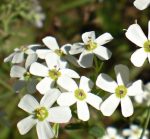 Also called prairie baby’s breath, flowering spurge is a herbaceous perennial and member of the euphorbia family, Euphorbiaceae, that also includes poinsettia, caster oil plant, and cassava. It is native to North America from Texas north to South Dakota and east to the Atlantic coast where it grows in open woodlands, prairies, pastures, glades, abandon fields, mined lands, and in waste areas such as along roadsides and railroad train tracks. Growing from a deep tap root, flowering spurge is 1-3′ feet tall and has smooth light green stems that are branched at the top. The oblong leaves are gray-green to green, , up to 2 1/2 inches long, and alternate to the top where they form a whorl of three or more around the inflorescence. Both leaves and stem contain a white latex that may cause skin and eye irritation. The male and female flowers are 1/4″ across and lack petals but have white petaloid bracts, and are carried on the same plant in loose terminal panicles up to 1″ across. They bloom throughout the summer and the female flowers give way to three sided capsules. Plants spread by seed and short rhizomes and can become weedy. The genus name, Euphorbia, honors the ancient Greek herbalist and personal physician of Juba II, King of Mauretania, an area in North Africa. The specific epithet, corollata, is the diminutive of the Latin word corolla meaning crown and refers to the petaloid bracts of the plant.
Also called prairie baby’s breath, flowering spurge is a herbaceous perennial and member of the euphorbia family, Euphorbiaceae, that also includes poinsettia, caster oil plant, and cassava. It is native to North America from Texas north to South Dakota and east to the Atlantic coast where it grows in open woodlands, prairies, pastures, glades, abandon fields, mined lands, and in waste areas such as along roadsides and railroad train tracks. Growing from a deep tap root, flowering spurge is 1-3′ feet tall and has smooth light green stems that are branched at the top. The oblong leaves are gray-green to green, , up to 2 1/2 inches long, and alternate to the top where they form a whorl of three or more around the inflorescence. Both leaves and stem contain a white latex that may cause skin and eye irritation. The male and female flowers are 1/4″ across and lack petals but have white petaloid bracts, and are carried on the same plant in loose terminal panicles up to 1″ across. They bloom throughout the summer and the female flowers give way to three sided capsules. Plants spread by seed and short rhizomes and can become weedy. The genus name, Euphorbia, honors the ancient Greek herbalist and personal physician of Juba II, King of Mauretania, an area in North Africa. The specific epithet, corollata, is the diminutive of the Latin word corolla meaning crown and refers to the petaloid bracts of the plant.
Type: herbaceous perennial
Bloom: Loose terminal panicles of white male and female flowers on the same plant in July and August
Size: 1-3′ h 1-2′ W
Light: Full sun to partial sun
Soil: Average, medium moist to dry, well-drained
Hardiness: Zones 3-9
Care: low maintenance
Pests and Diseases: None of significance
Propagation: Seed, division
Companion Plants: Purple prairie clover, lead plant, lance-leaf coreopsis